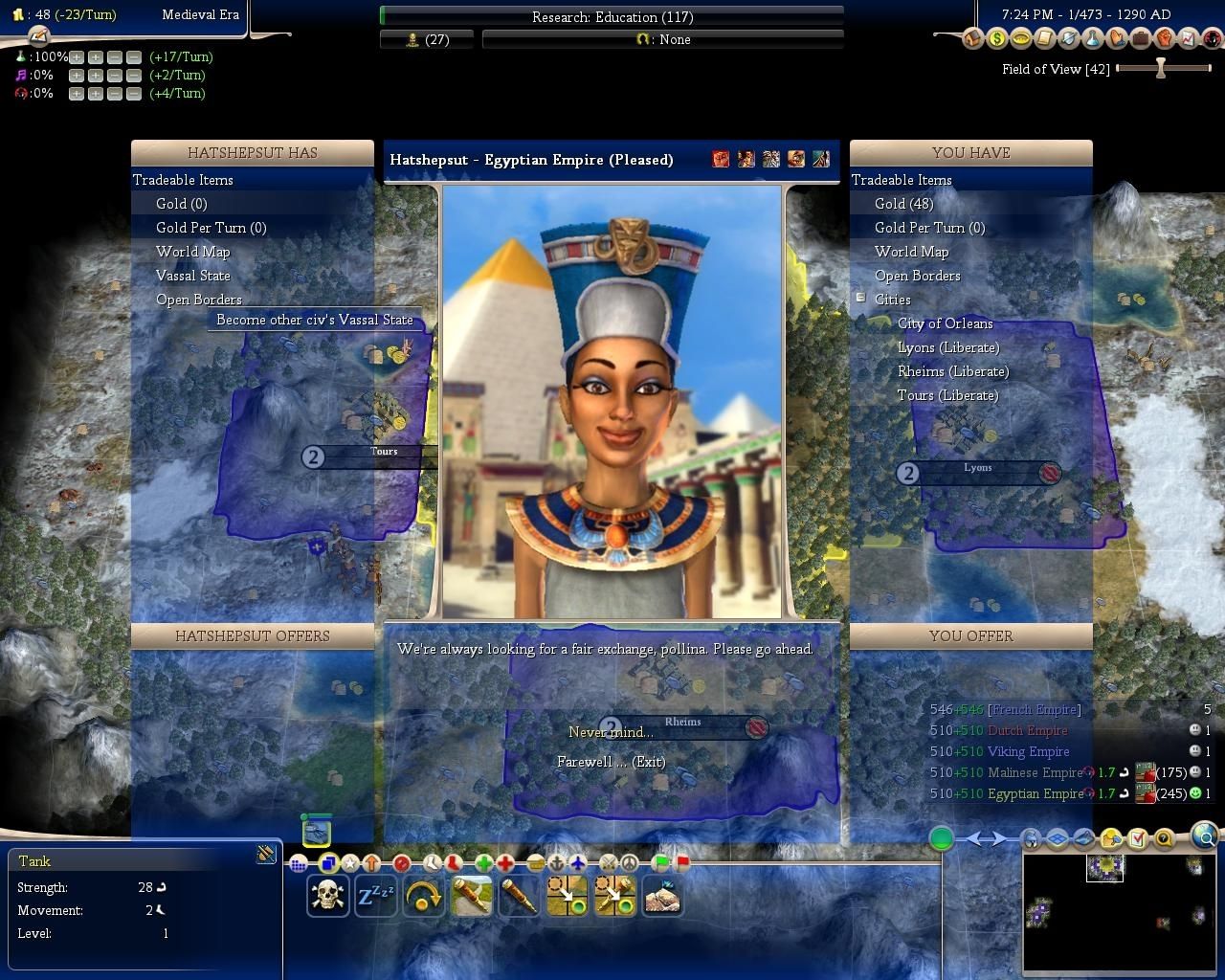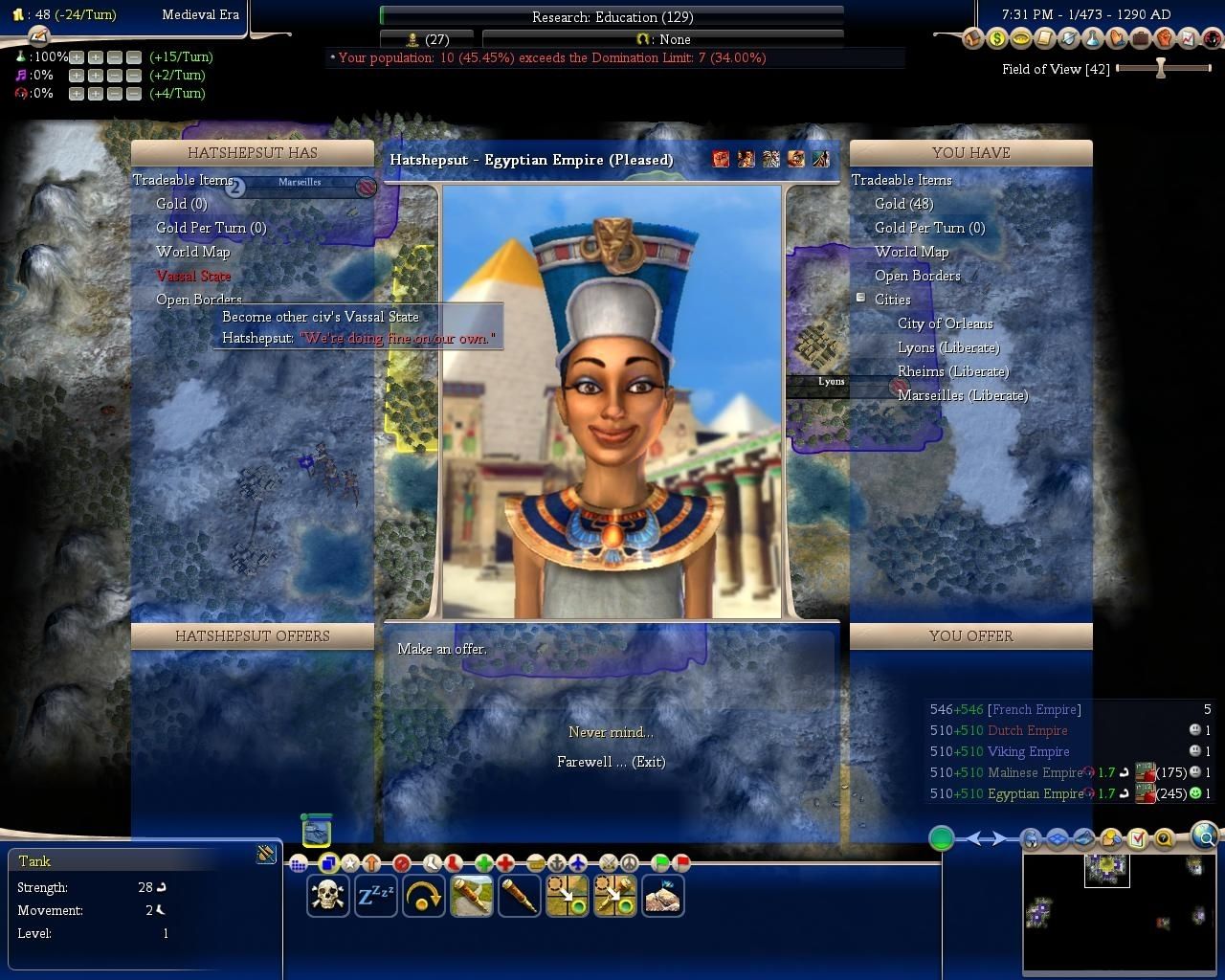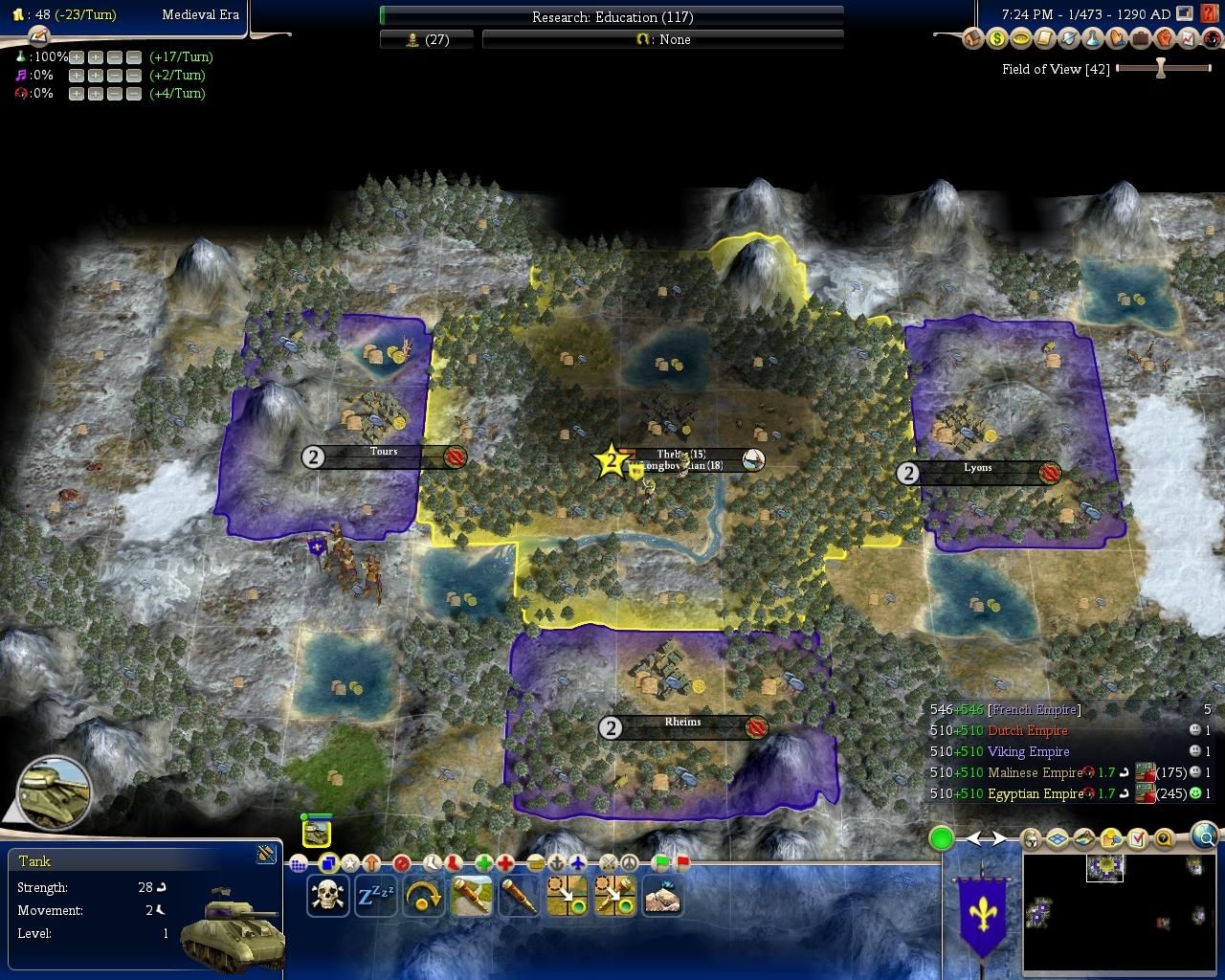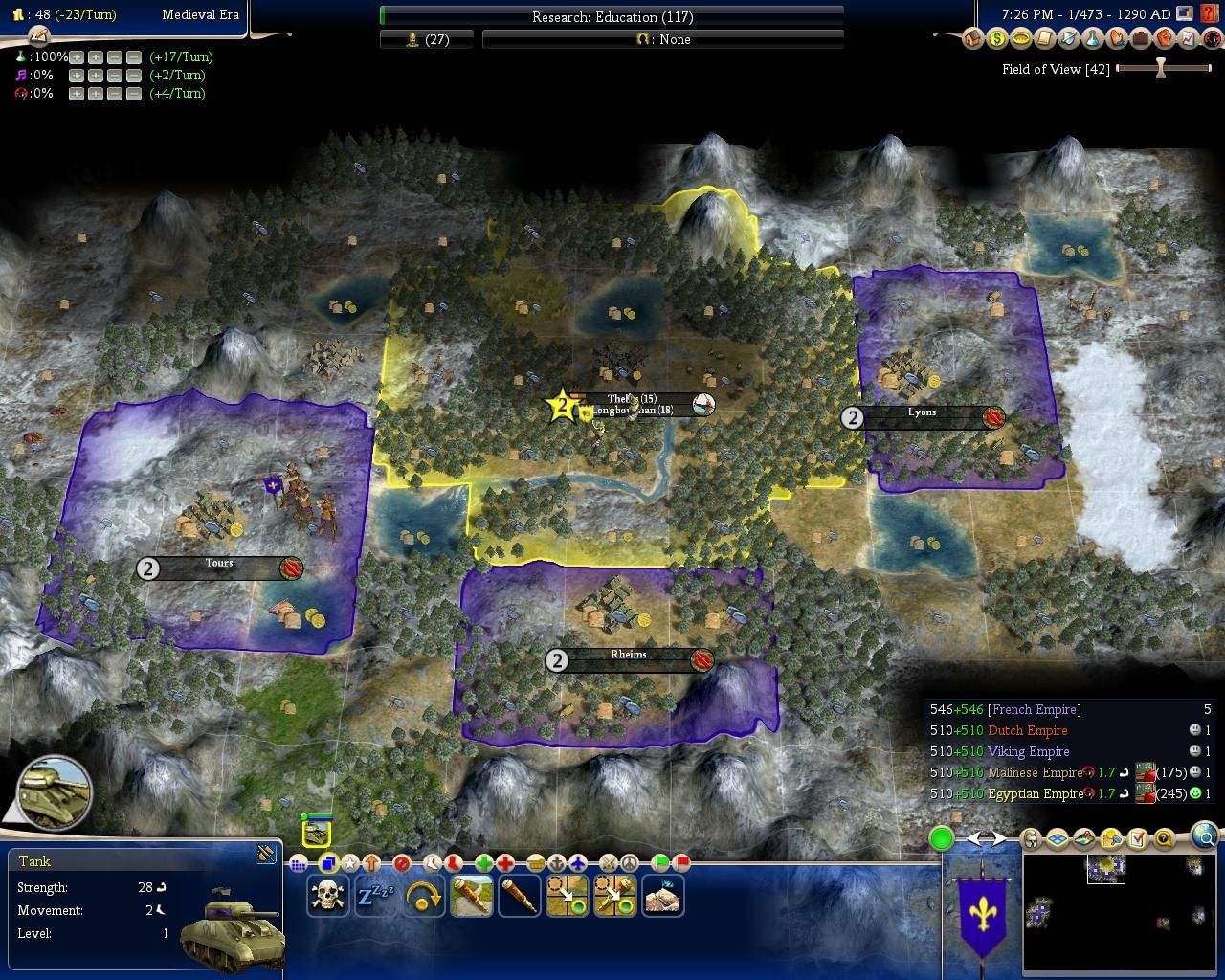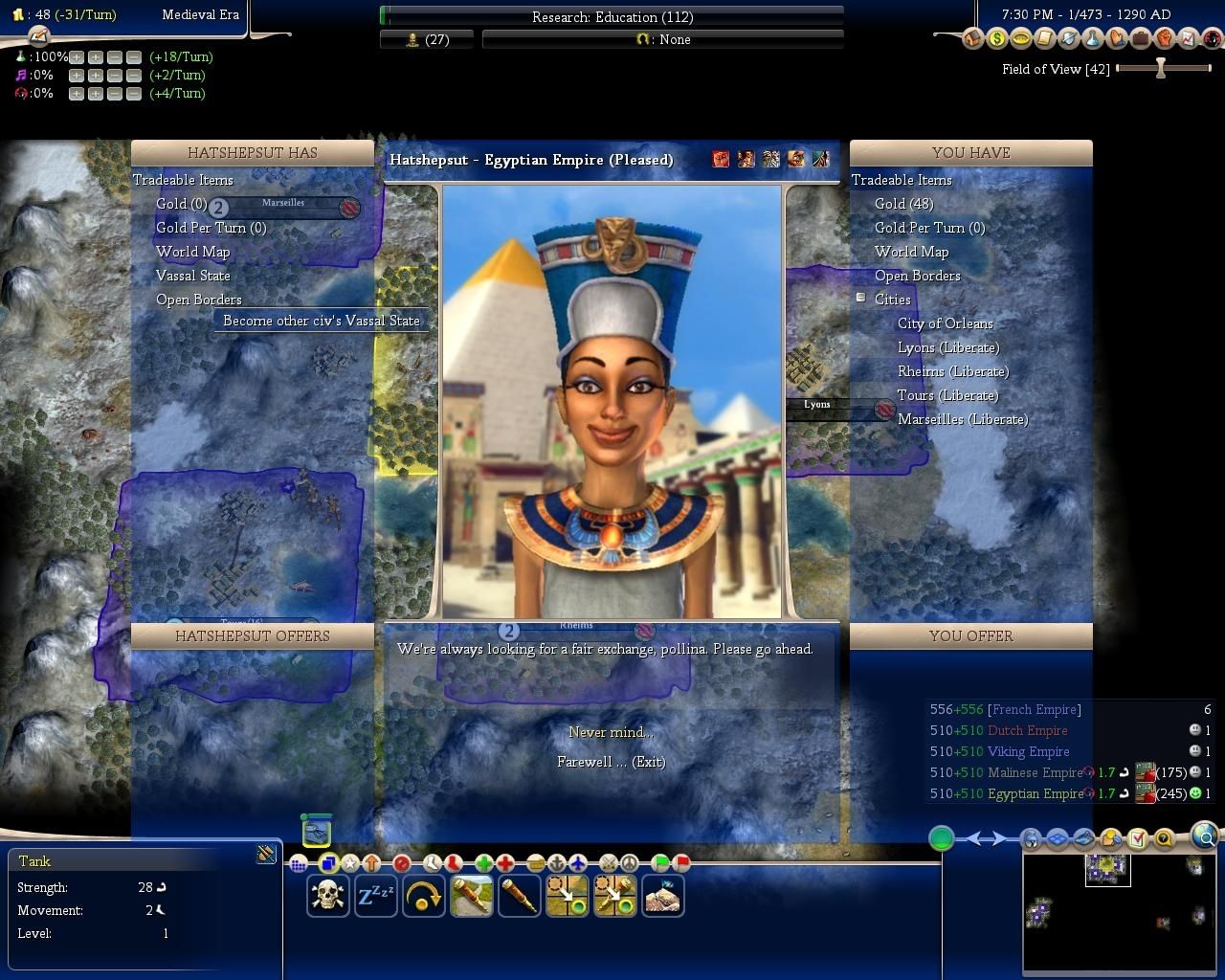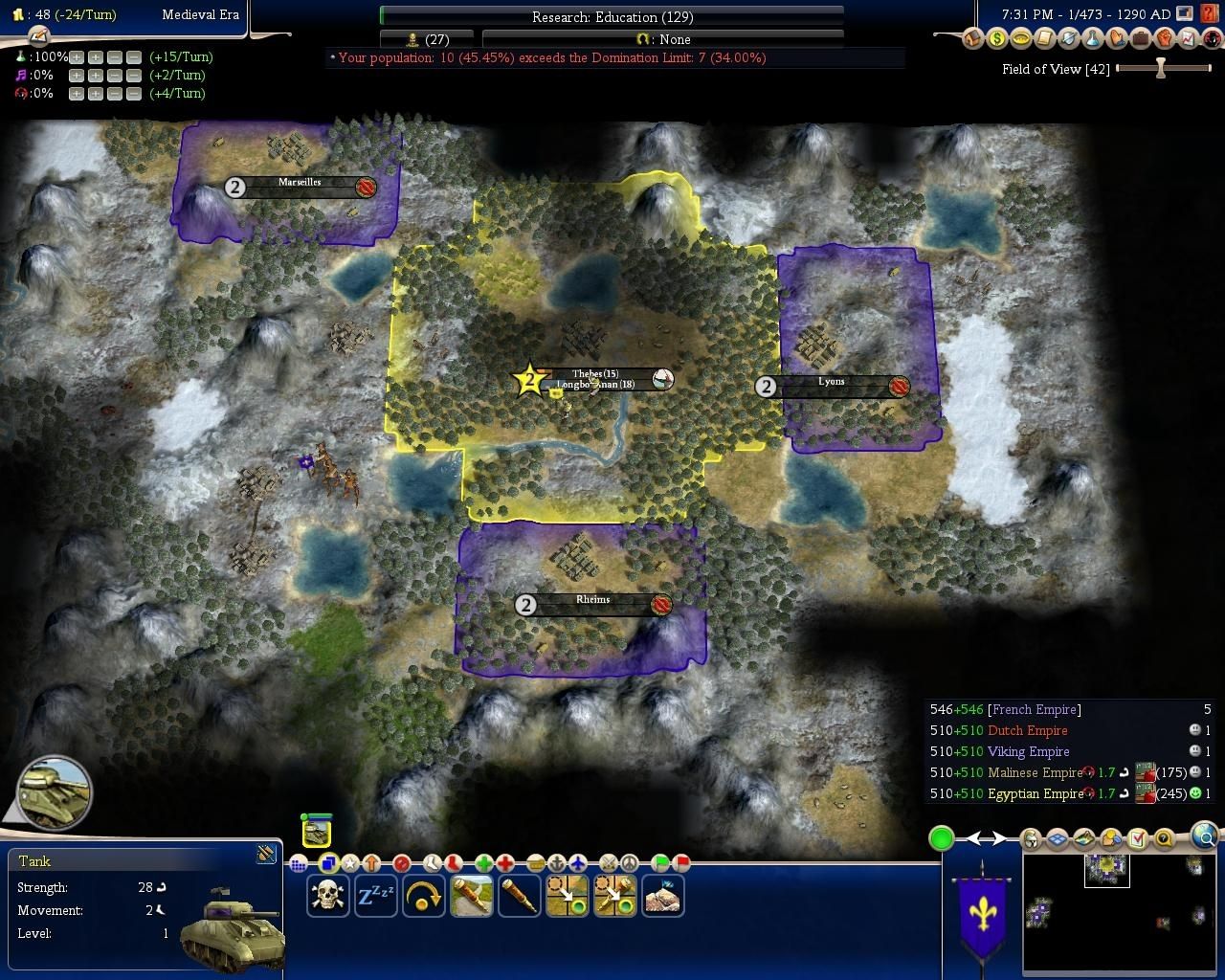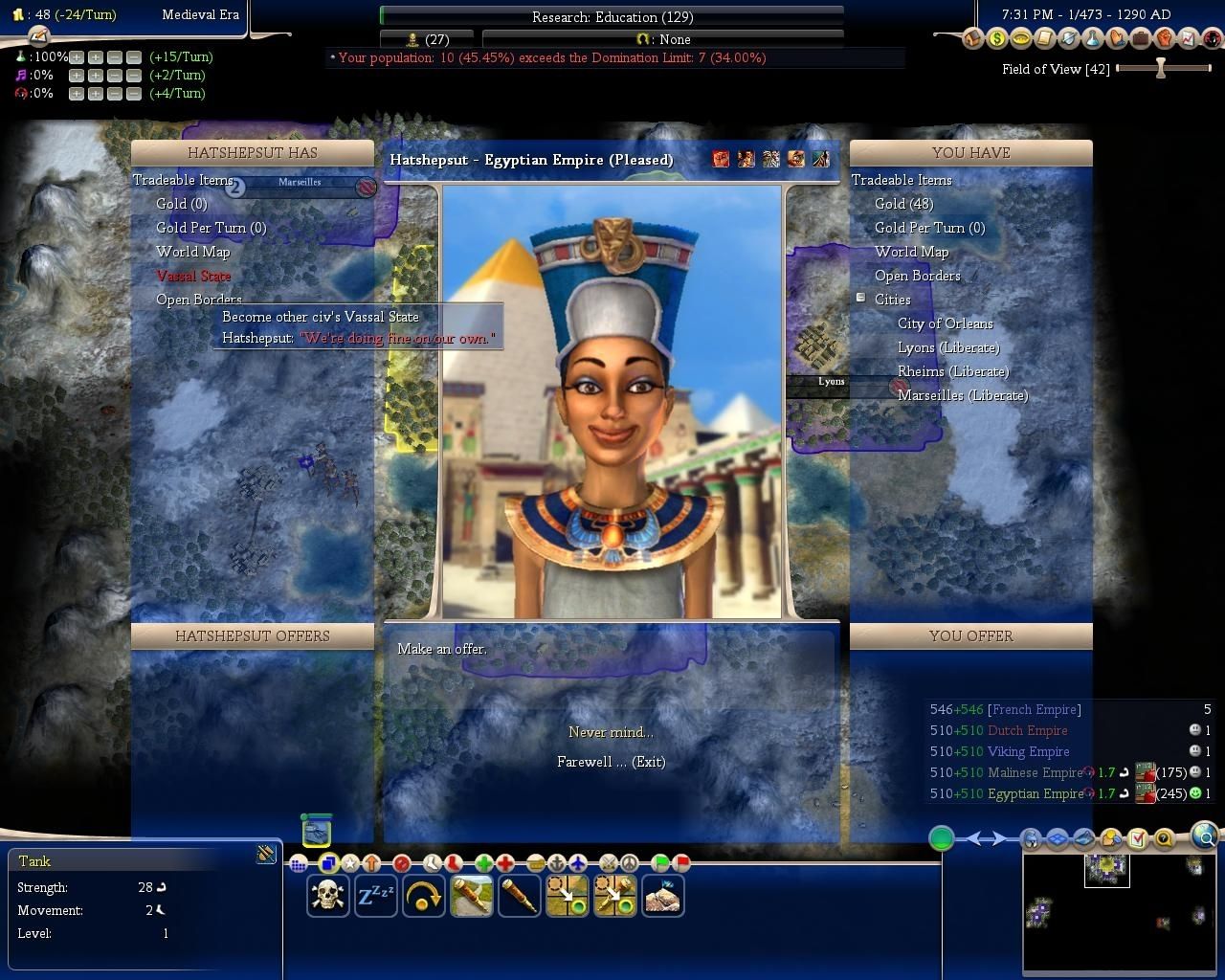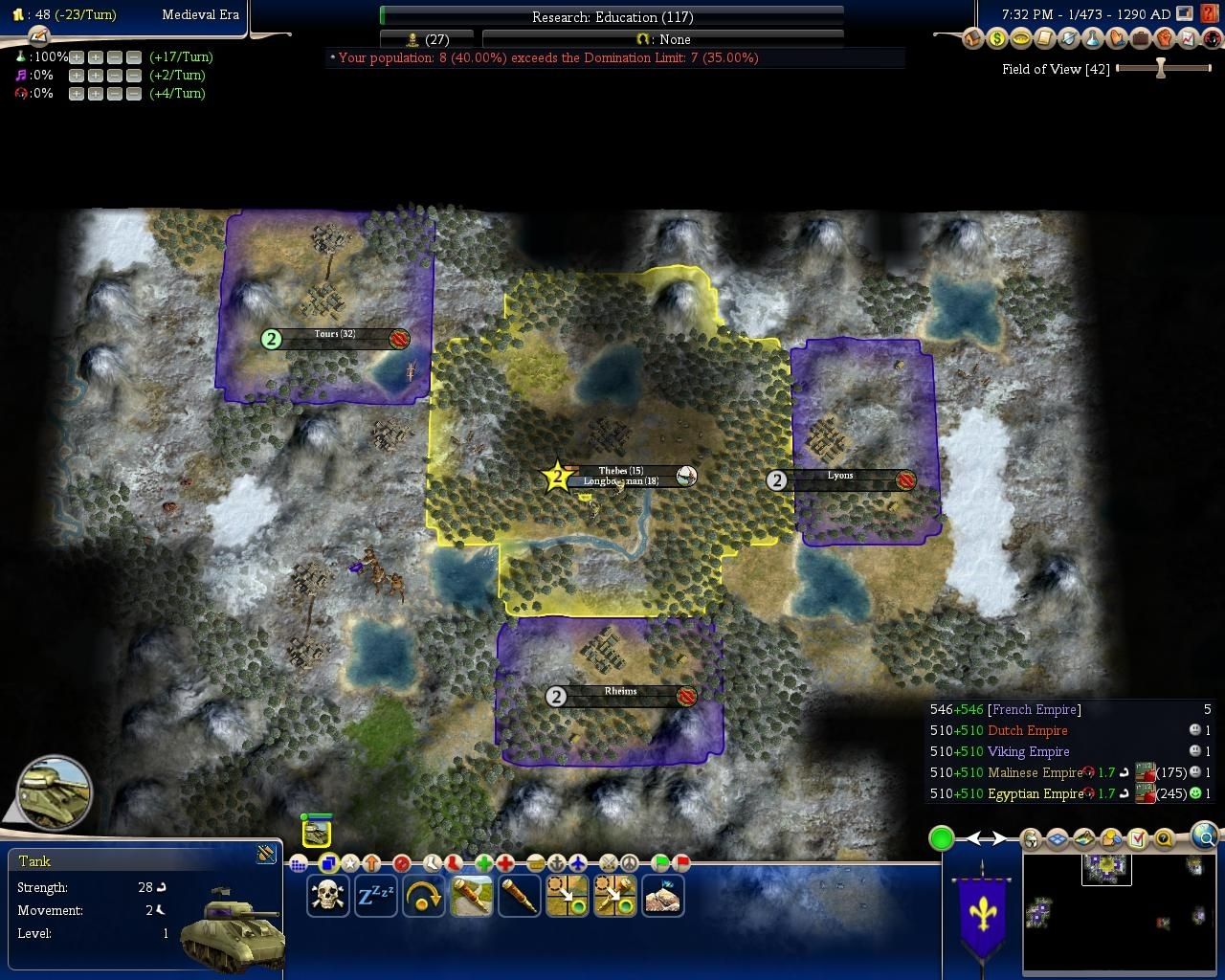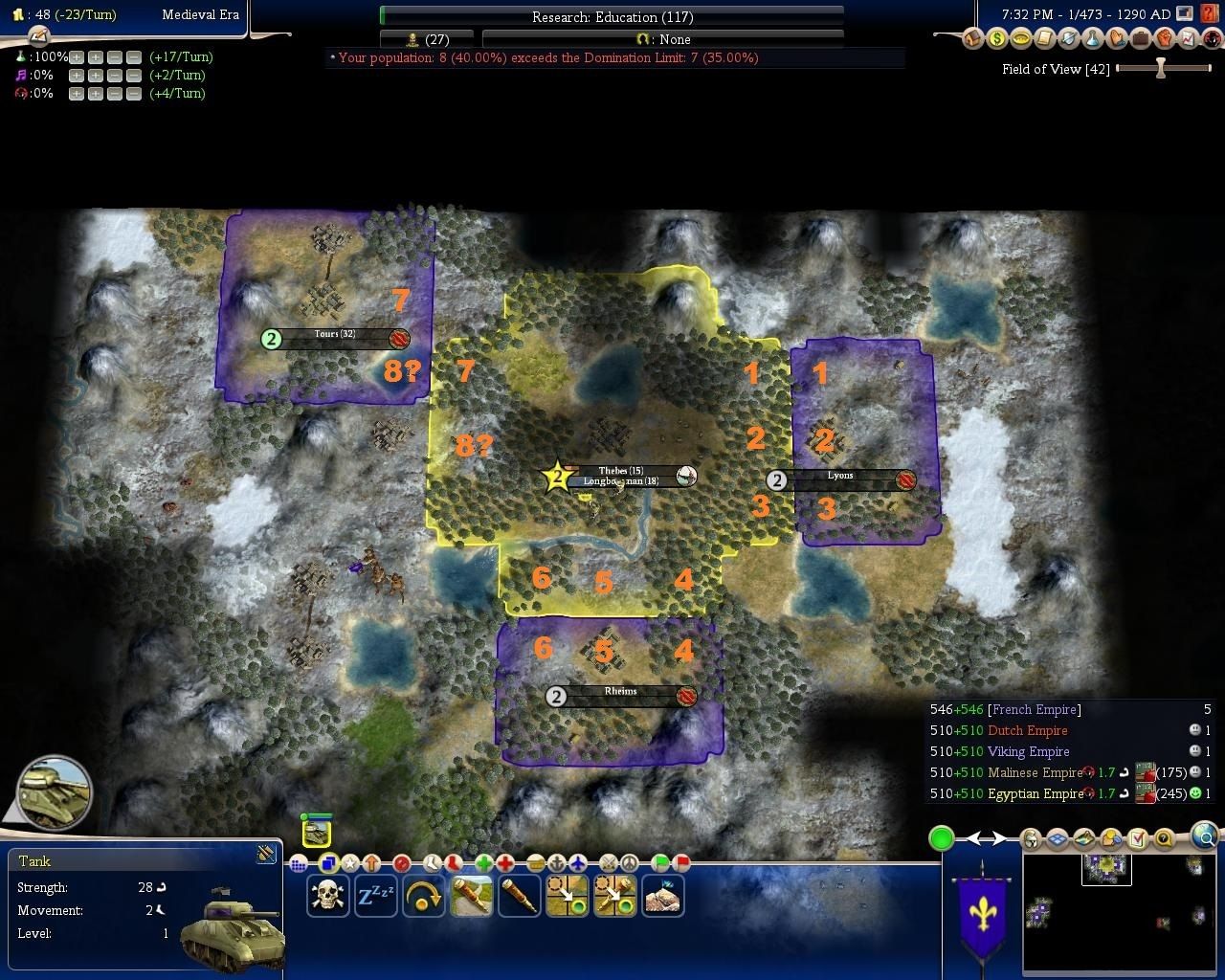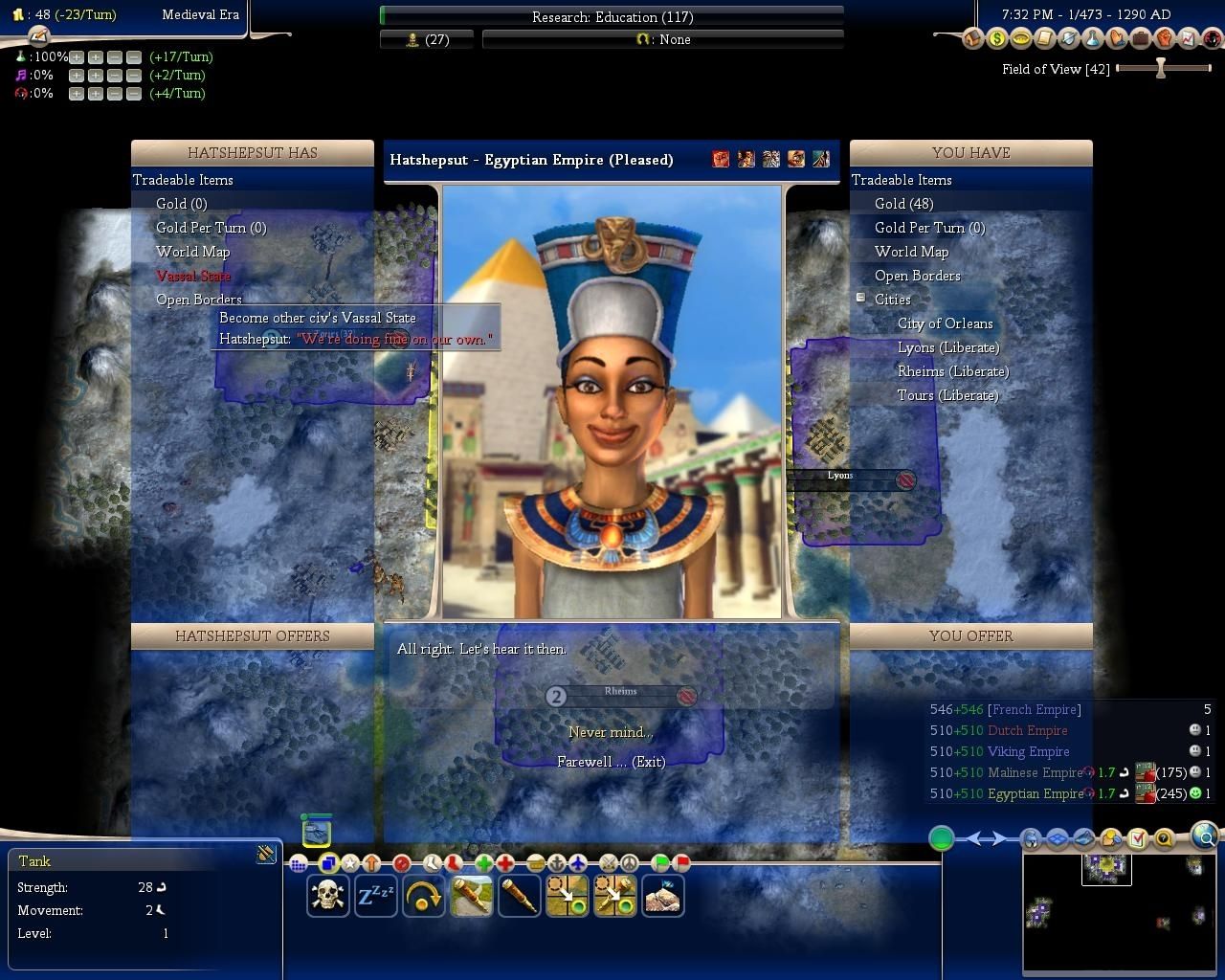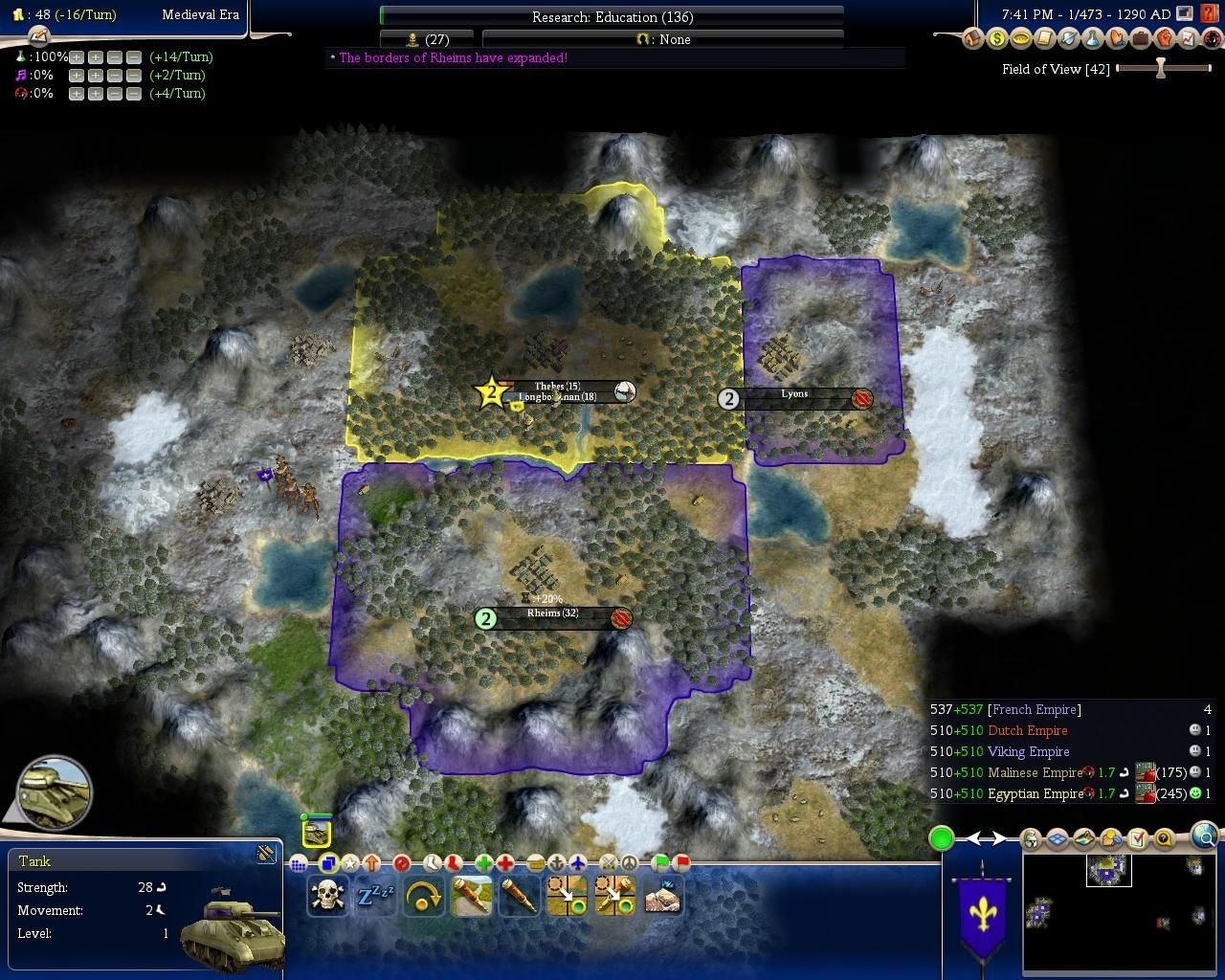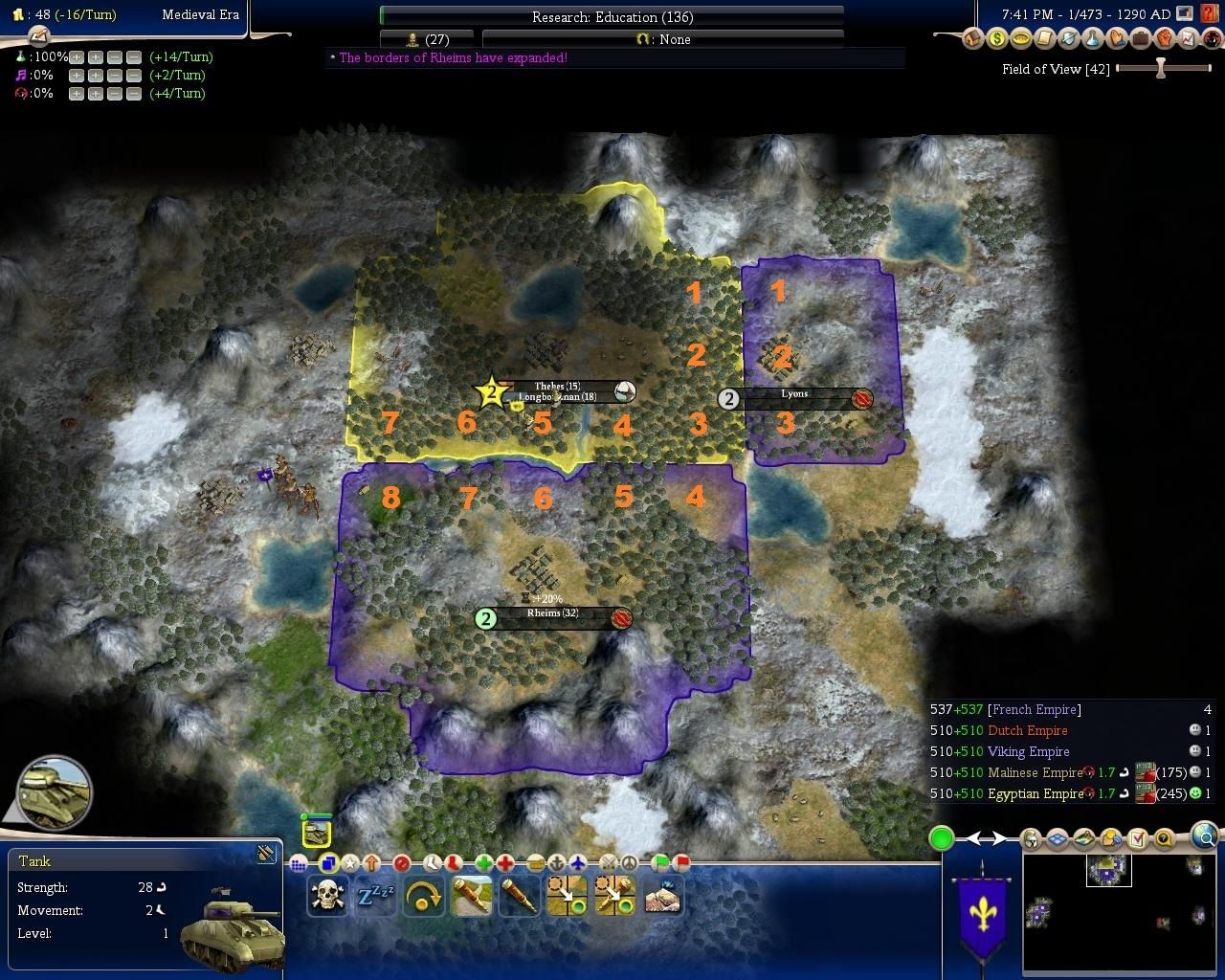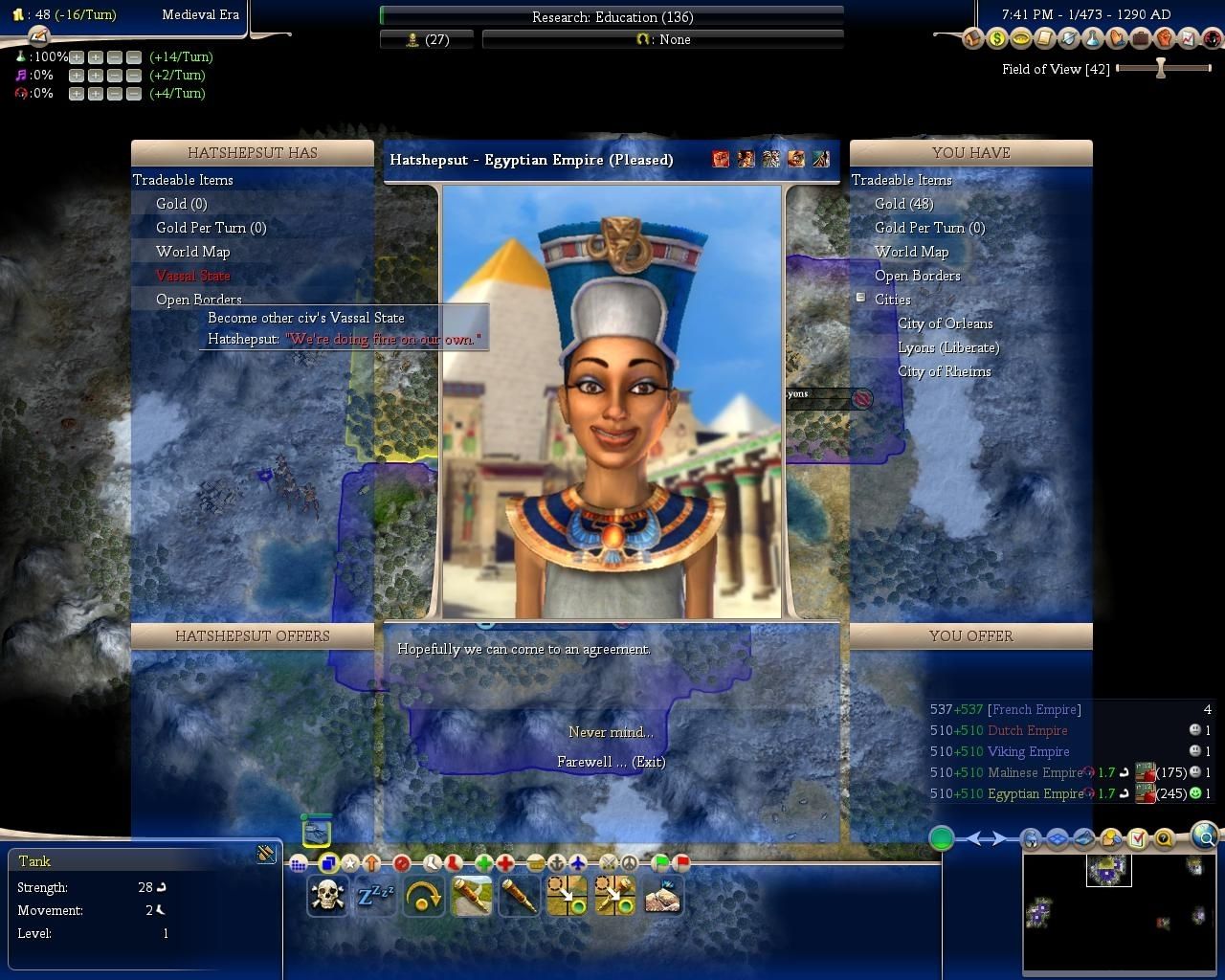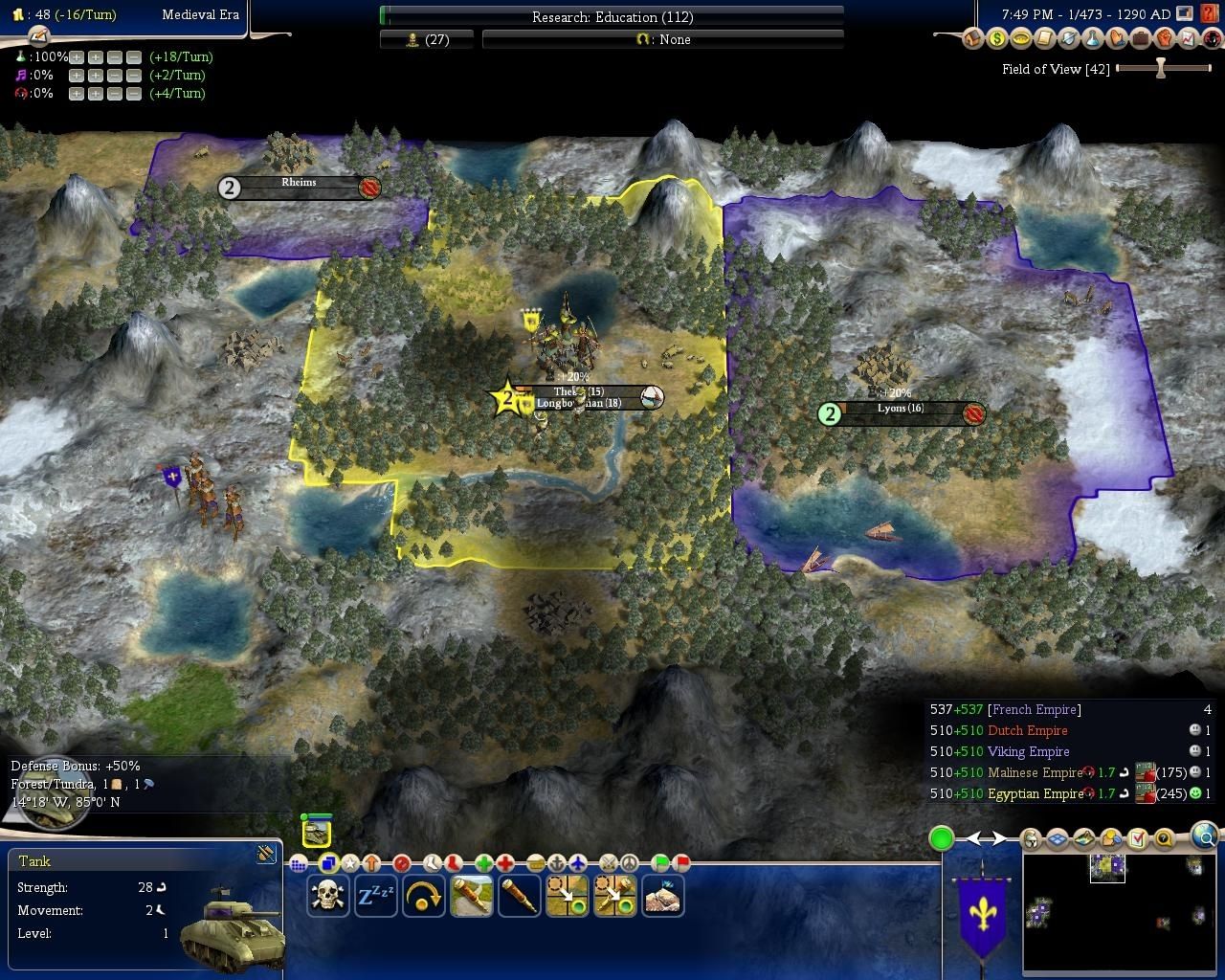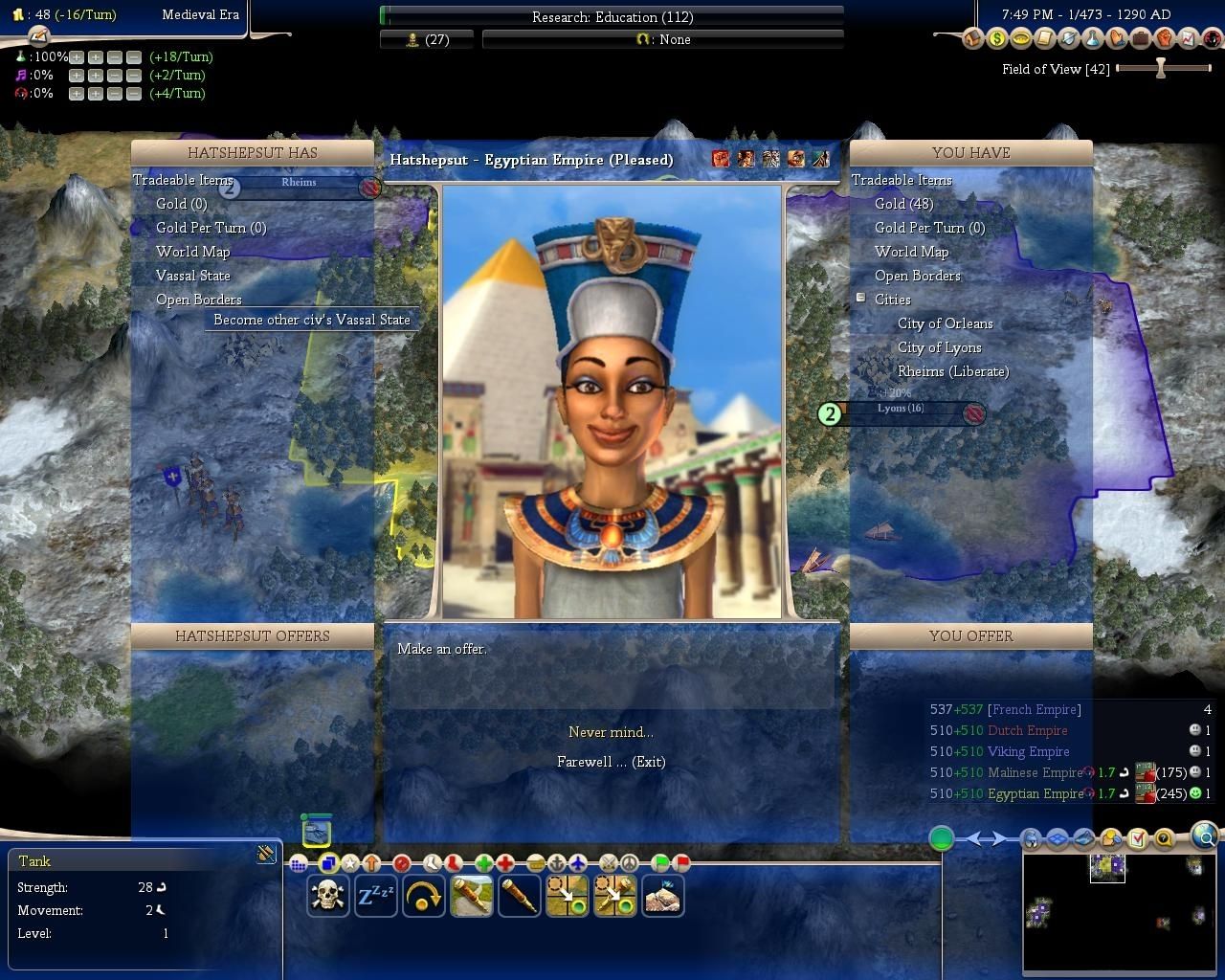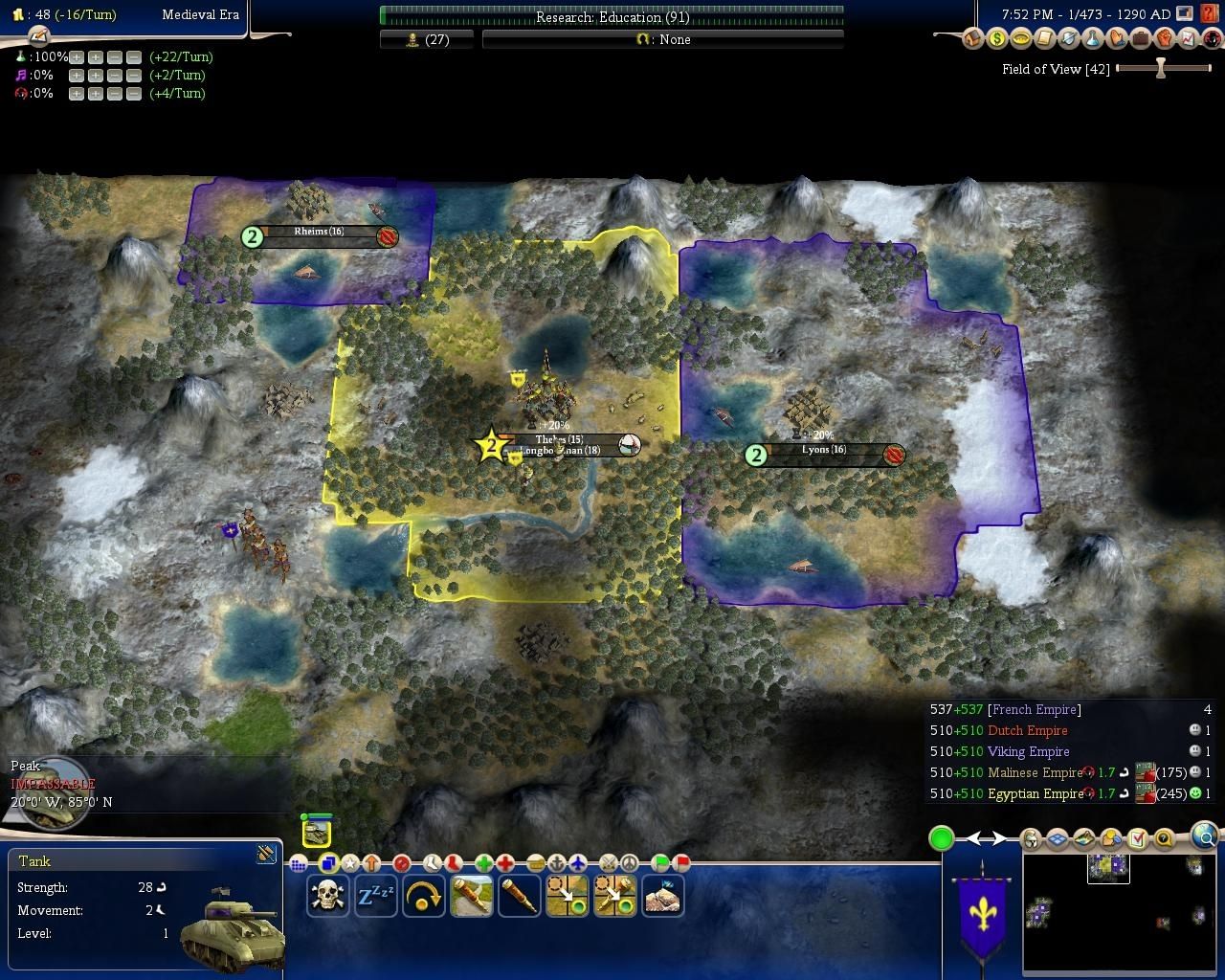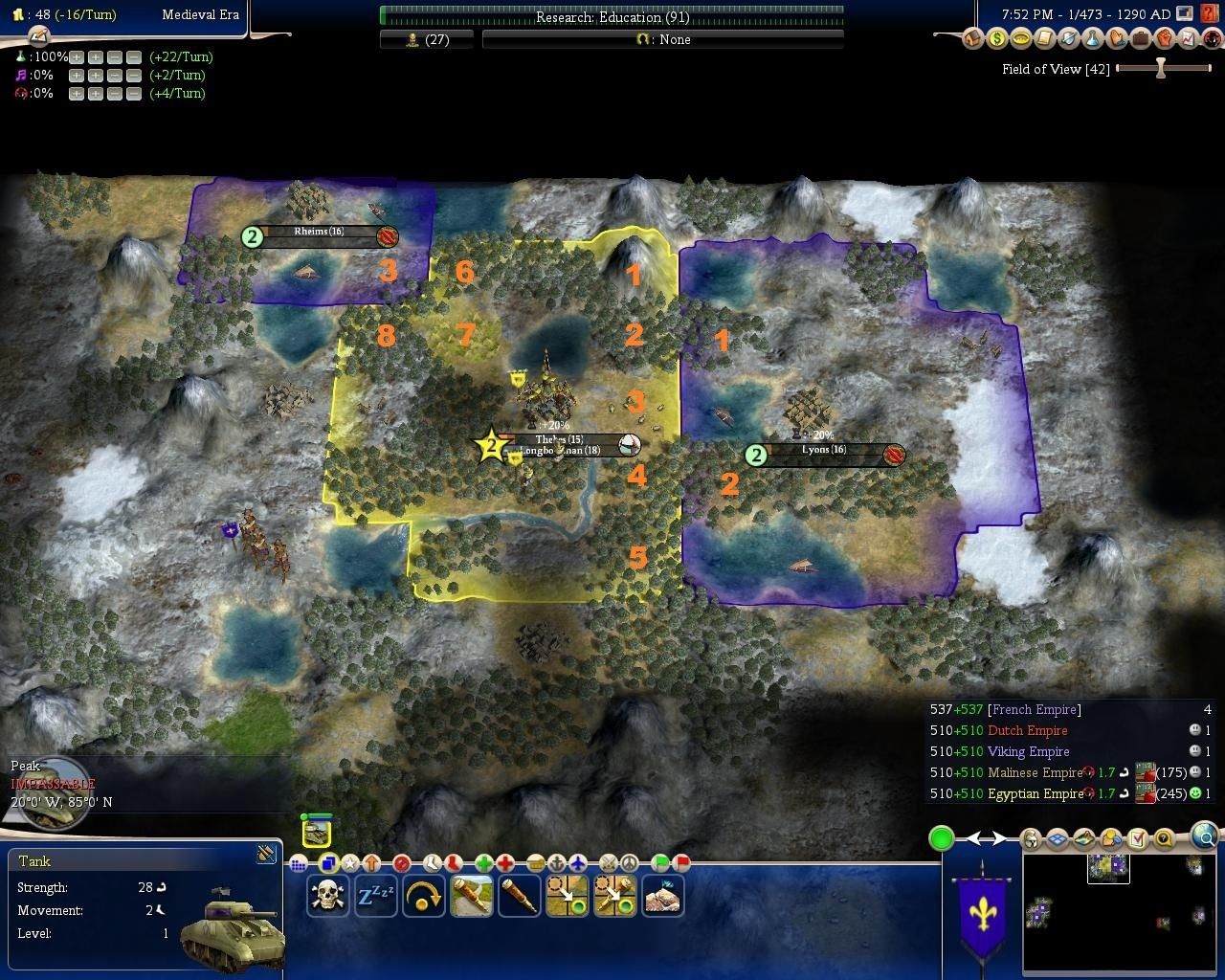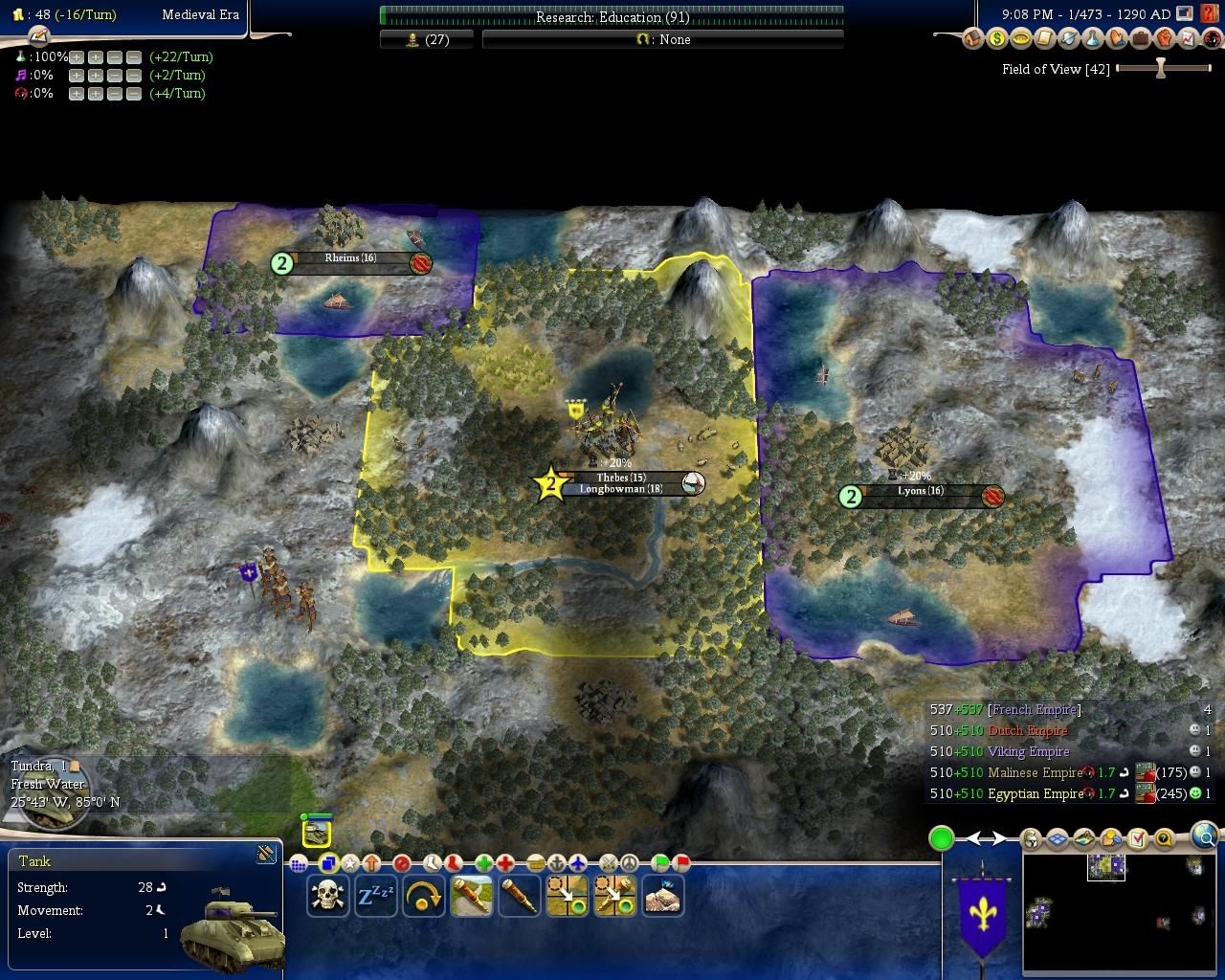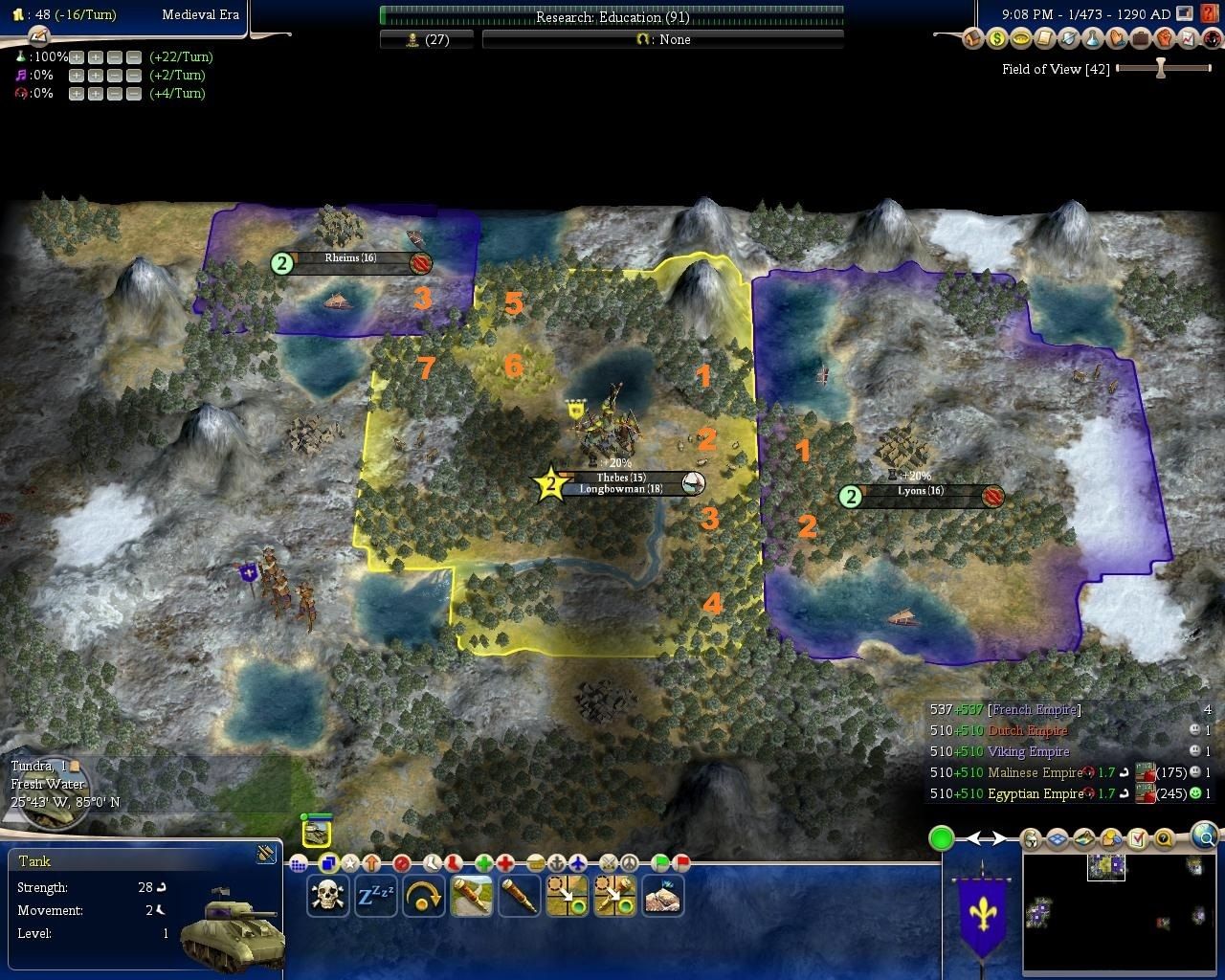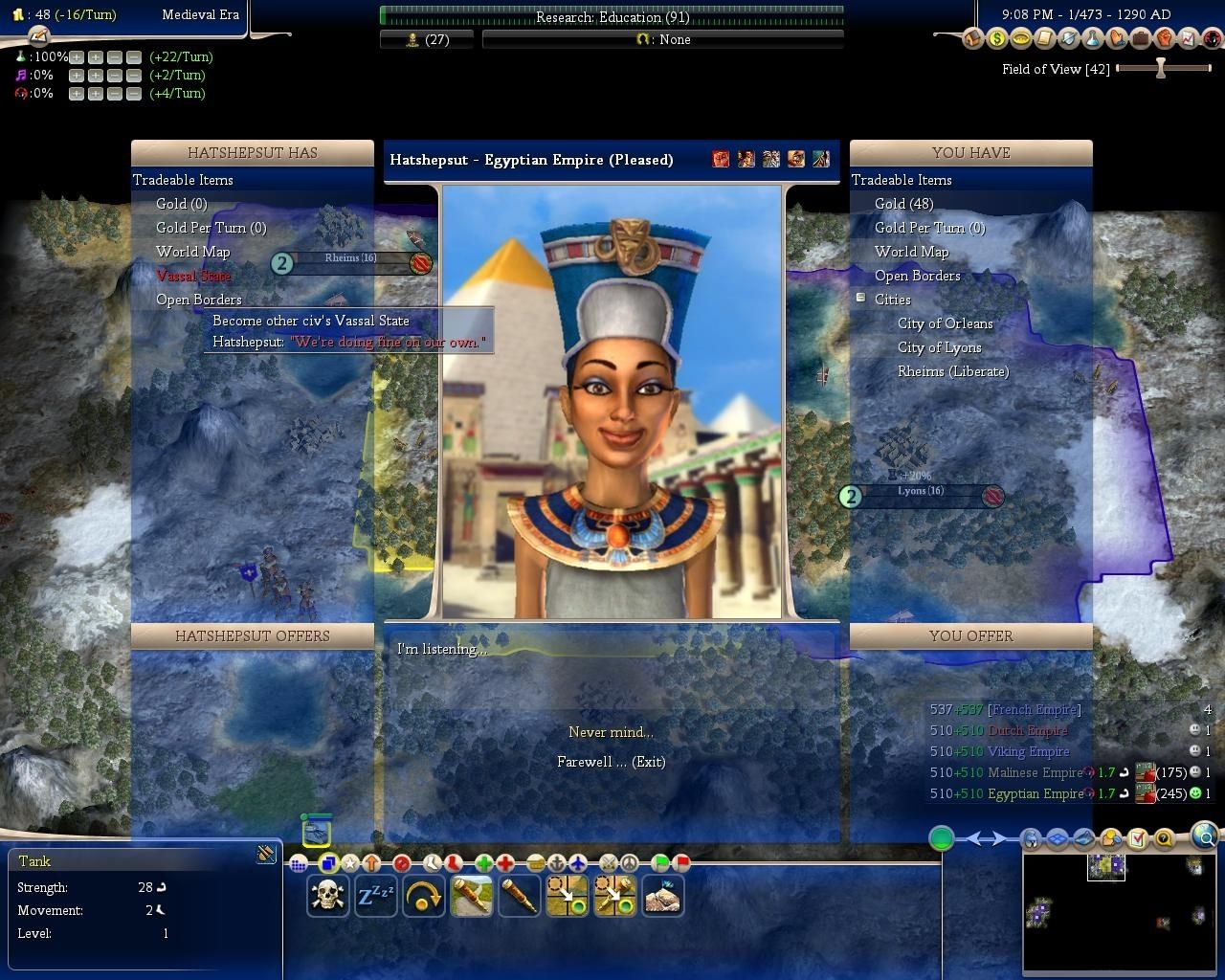Whipping Mechanics Part 2
VoiceofUnreason also talks very well about turning

into

efficiently.
FOOD
The whip is converting population to hammers, which in effect is translating food to hammers. So to properly understand efficient whipping, it is important to see the precise relationship involved.
The key point is this: cracking the whip does not change the amount of food collected in the food bin. It does, however, reduce the population, which reduces the amount of food required to regrow a population point. For example, if the food bin is at 20/30, and you whip three population, the bin will then be at 20/24.
The sweet spot for the whip will be that point where, having whipped the population, you are immediately growing one of the whipped population back. In this way, you get the hammers without sacrificing more turns working your tiles than is absolutely necessary (you will necessarily lose one turn of work, because city production comes before growth).
The Granary plays a significant role in whipping efficiency, because of the enormous impact it has on growth rates. The way the granary works is very simple - each turn you have a food surplus, the food stored in the granary increases by the same amount (likewise, if you are running at a food deficit, you lose food in the granary as well). The capacity of the granary is capped at 1/2 the food required to grow to the next size.
How much surplus food is required to grow from 24/30 to 24/32? Without the granary, the math is straightforward - 6 food to hit 30 (at which point the city grows one size), then another 24 to fill the food bin to the desired level. With a granary, we need the same 6 food to grow, but at that point our food bin is at 15/32 - we need only 9 more food to get to 24/32 - the amount of food required to grow has been chopped precisely in half.
In other words, the presence of the granary reduces the amount of food each population represents by 50%, thereby doubling the efficiency by which we convert food into hammers.
Whipping the Granary
I see this question all the time.
When do I whip the Granary complete?
I would respond that a city that will spend the next 10 turns growing and has enough gold/gems/ivory to manage happiness is a good candidate.
Whipping a Granary and then slowly building a bunch of Settlers and Workers is no good.
The most important thing to remember is the Granary does not begin storing  until it is listed as one of your cities' buildings.
until it is listed as one of your cities' buildings.
It will then store food each turn that matches the city surplus and maxes out at 1/2 the food bin. (A Size 1 city has 22

bin, Size 2 city has 24

bin, etc.)
So a Size 1 city that needs 22

to grow to Size 2 can only bring 11

when the city grows.
This city here just completed a Granary and is producing +5

per turn at Size 1.
It will grow to Size 2 in two turns when it reaches 24/22

, and the Granary will bring 10

to add to the 2

overflow.
There are many guides floating around on when to best whip the Granary since it is a great optimization problem due to the
Halt City Growth button below the whip button. (Popularized by
Doshin I think)
Say a city completes a Granary at Size 2 and then has 18/24

It works two cow tiles and generates +6

per turn.
Halt growth is turned on and the next turn the city is still Size 2 at 24/24

Halt growth is turned off and the next turn the city is Size 3 at 18/24

Without Halt Growth button, the city reaches Size 3 at 6/24

and then Size 3 at 12/24

It has 6 less food if it doesn't use the Halt Growth Button!

Keep in mind the Halt Growth button causes any extra food to be discarded (28/24

becomes 24/24

), but the granary still stores food up to its max.
Interesting to think about, especially if the city can't grow onto another big food tile.
Here are some granary discussions:
https://forums.civfanatics.com/threads/whiping-a-granary.668214/
https://forums.civfanatics.com/threads/how-exactly-does-a-granary-store-food.623090/
https://forums.civfanatics.com/threads/why-is-granary-so-important.521018/
Discarding whip anger
A very high

city with 2 corn and 3 fish can quickly run up 6 or 7 whip anger especially on slower speeds.
It turns out that
giving the city away clears the whip anger (draft anger too) 
, and conquering it back instantly is just a Chariot and a war away!
The details have to be carefully considered though.
1) Consult the "City Gifting" guide once it is written to learn how to give away a city.
2) The city
needs to have at least 1
for this to work. A religion in the city giving free

or using a Cultural Civ that gets +2

per turn is ideal.
3) Because a gifted city will usually have all 9 tiles around it become the new AIs' territory, conquering the city is best done with a Chariot or 2

unit right away. (So
you'll need Horse usually)
4) If the AI receiving the city gift is the worst enemy of another AI (Annoyed and has the lowest diplomacy total), then the player will get
-4 "You have traded with our worst enemy!" diplo points with that AI.

5) The city will have to
start over with 0
and 0 great people points once it is reconquered.
6) The city will
lose certain buildings on being reconquered such as Monument, Library, University, Theatre etc. the

producing ones.

7) When declaring war on the AI to take your city back, you will get
-1 "You declared war on our friend" diplo points with every AI that is Pleased or Friendly with your target.
You will also have to fight a war with them.
Warning: If the city was gifted away
with 0 in it
in it, it will experience -1 population loss, at least 3 turns of Anarchy, and extra buildings lost like Walls or Barracwhen reconquered
 Warning:
Warning: The gifted city will lose plot

on the city tile and surrounding 8 tiles, so
don't do this with a city bordering an AI with strong culture pressure.
You will get your city back after the war starts and it won't be able to work any tiles hardly since the neighbor now controls them all.

With all the disadvantages, I tend to only clear 6 or 7 whip anger in a Marathon or Epic speed game using a 1-city AI to take the city gift.
Creative Civs (+2

per turn) have a real advantage with this technique because lost Monuments are no biggie and lost Libraries can be rebuilt quickly because of +100%

for Library construction.
Queue management for whipping
It can be tempting to put 1

into a bunch of different units and buildings to be ready to whip and produce them one after another in the future.
Keep in mind that
production decay occurs after a certain amount of turns that removes 1

per turn from the build each turn it isn't produced.
Unit decay starts after
10 turns (cumulative) of no production
Building + Wonder decay starts after
50 turns (cumulative) of no production.
It is also possible to whip an item and then not produce it that turn by taking it off the queue.
Perhaps the city has 2 angry citizens that can be whipped away now to save some food?
And the player is planning to switch to Vassalage + Theocracy in 2 turns?
Whip that Cavalry and hold off producing it until it can get +4xp.
The queue can be managed by left or right clicking to take an item off the queue.
Control + Left click adds an item to the top of the queue.
Shift + Left click adds an item to the bottom of the queue.
Managing  overflows from whips
overflows from whips
One of the best tricks of whipping is to whip away more than one population to get a large

surplus.
This can then be put into something hard to whip the following turn such as a wonder.
What are the
mechanics of  overflow
overflow though?
Here is the
1st example with a Warrior at 1/15

in a city with a Forge (+25%

)
The city produces 1

per turn.
1-population whipping instantly adds 30*1.25=37.5->37

to the Warrior bringing it to 38/15

The city adds 1

total production bringing the final total to 39/15

for the Warrior generating a 39-15=24

surplus.
The  overflow cap is the greater of either the cost of the item being built which is 15
overflow cap is the greater of either the cost of the item being built which is 15 for the Warrior or 1
for the Warrior or 1 for the cities' Total Production.
for the cities' Total Production.
Every

past 15

in this example gets discarded in Beyond the Sword 3.19 (they just vanish!

) or turn into

in the Buffy Mod (24-15=9

Cha-Ching!

)
This 15

overflow that has been capped then gets divided by any production bonus modifiers before carrying over into the next turn.
15/1.25=12

overflow next turn.
Here is a
2nd example with a Warrior at 1/15

in the same city with a Forge (+25%

)
The city naturally produces 17

or 17*1.25=21.25 or 21

Total Production with Forge bonus when rounded down.
1-population whipping instantly adds 30*1.25=37.5->37

to the Warrior bringing it to 38/15

The city adds 21

total production bringing the final total to 59/15

for the Warrior generating a 59-15=44

surplus.
The  overflow cap is the greater of either the cost of the item being built which is 15
overflow cap is the greater of either the cost of the item being built which is 15 for the Warrior or 21
for the Warrior or 21 for the cities' Total Production.
for the cities' Total Production.
Every

past 21

in this example gets discarded in Beyond the Sword 3.19 (they just vanish!

) or turn into

in the Buffy Mod (44-21=23

Cha-Ching!

)
This 21

overflow that has been capped then gets divided by any production bonus modifiers before carrying over into the next turn.
21/1.25=16.8->16

overflow next turn.
It is entirely possible to manipulate

overflows by whipping a 299/300

Cathedral complete using Stone for +100% bonus production.
Then gift away stone or pillage the stone quarry once the Cathedral is at 359/300

and enjoy 59

overflow the next turn instead of the usual 29

Thanks
LowtherCastle  What happens if I whip something that can no longer be produced?
What happens if I whip something that can no longer be produced?
If you whip a Chariot and give away your horse, or whip a Missionary and switch out of Org. Religion,
then the item gets taken off the queue and is not produced.
Not a huge deal.
Get the Horse back before production decay hits and producing that 37/30

whipped Chariot can proceed smoothly.
How about whipping a
World Wonder that an AI has already completed?
It is true that an Industrious civ with Marble might benefit from whipping the missed Oracle to get just a bit more fail

.
Just remember that any forest chops or Total Production a city tries to put into an item that can't be produced will just carry over to the next turn.
Repeatedly putting

into an item that can never be produced such as a Knight when you keep pillaging your only source of horse each turn is
banned in competitive play.

A tidal wave of

far beyond the overflow cap can build a spaceship in 1 turn easily.









 for 10 turns and stacks each time it's used.
for 10 turns and stacks each time it's used.


 into
into 




 for this to work. A religion in the city giving free
for this to work. A religion in the city giving free  unit right away. (So you'll need Horse usually)
unit right away. (So you'll need Horse usually)
 in the Buffy Mod (24-15=9
in the Buffy Mod (24-15=9

















































 )
)
